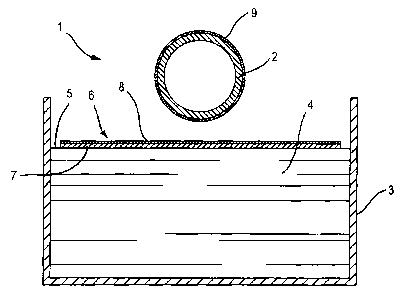Une partie des informations de ce site Web a été fournie par des sources externes. Le gouvernement du Canada n'assume aucune responsabilité concernant la précision, l'actualité ou la fiabilité des informations fournies par les sources externes. Les utilisateurs qui désirent employer cette information devraient consulter directement la source des informations. Le contenu fourni par les sources externes n'est pas assujetti aux exigences sur les langues officielles, la protection des renseignements personnels et l'accessibilité.
L'apparition de différences dans le texte et l'image des Revendications et de l'Abrégé dépend du moment auquel le document est publié. Les textes des Revendications et de l'Abrégé sont affichés :
| (12) Brevet: | (11) CA 2511791 |
|---|---|
| (54) Titre français: | PROCEDE DE DECORATION D'OBJETS AU MOYEN D'UNE IMAGE D'ENCRE TRANSFERABLE |
| (54) Titre anglais: | METHOD FOR DECORATING OBJECTS USING A TRANSFERABLE-INK IMAGE |
| Statut: | Accordé et délivré |
| (51) Classification internationale des brevets (CIB): |
|
|---|---|
| (72) Inventeurs : |
|
| (73) Titulaires : |
|
| (71) Demandeurs : |
|
| (74) Agent: | SMART & BIGGAR LP |
| (74) Co-agent: | |
| (45) Délivré: | 2013-05-14 |
| (22) Date de dépôt: | 2005-07-11 |
| (41) Mise à la disponibilité du public: | 2007-01-11 |
| Requête d'examen: | 2010-06-17 |
| Licence disponible: | S.O. |
| Cédé au domaine public: | S.O. |
| (25) Langue des documents déposés: | Anglais |
| Traité de coopération en matière de brevets (PCT): | Non |
|---|
| (30) Données de priorité de la demande: | S.O. |
|---|
Une méthode de décoration d'un objet (2) comprend le positionnement sur la surface (5) d'un solvant (4) d'une pellicule de transfert (6) comportant une couche soluble (7) associée à une couche décorative (8) d'encres sublimables, et l'immersion dudit objet (2) dans ledit solvant (4) de sorte que ladite couche décorative (8) reste associée audit objet (2), ladite couche décorative (8) étant en contact direct avec ladite couche soluble (7) de ladite pellicule de transfert (6).
A method for decorating an object (2) comprises positioning on the surface (5) of a solvent (4) a transfer film (6) provided with a soluble layer (7) associated with a decorative layer (8) of sublimable inks, and immersing said object (2) in said solvent (4) so that said decorative layer (8) remains associated with said object (2), said decorative layer (8) being in direct contact with said soluble layer (7) in said transfer film (6).
Note : Les revendications sont présentées dans la langue officielle dans laquelle elles ont été soumises.
Note : Les descriptions sont présentées dans la langue officielle dans laquelle elles ont été soumises.

2024-08-01 : Dans le cadre de la transition vers les Brevets de nouvelle génération (BNG), la base de données sur les brevets canadiens (BDBC) contient désormais un Historique d'événement plus détaillé, qui reproduit le Journal des événements de notre nouvelle solution interne.
Veuillez noter que les événements débutant par « Inactive : » se réfèrent à des événements qui ne sont plus utilisés dans notre nouvelle solution interne.
Pour une meilleure compréhension de l'état de la demande ou brevet qui figure sur cette page, la rubrique Mise en garde , et les descriptions de Brevet , Historique d'événement , Taxes périodiques et Historique des paiements devraient être consultées.
| Description | Date |
|---|---|
| Inactive : COVID 19 - Délai prolongé | 2020-07-02 |
| Requête pour le changement d'adresse ou de mode de correspondance reçue | 2019-11-20 |
| Représentant commun nommé | 2019-10-30 |
| Représentant commun nommé | 2019-10-30 |
| Inactive : Page couverture publiée | 2013-09-26 |
| Inactive : Acc. récept. de corrections art.8 Loi | 2013-09-24 |
| Demande de correction d'un brevet accordé | 2013-09-20 |
| Accordé par délivrance | 2013-05-14 |
| Inactive : Page couverture publiée | 2013-05-13 |
| Préoctroi | 2013-02-22 |
| Inactive : Taxe finale reçue | 2013-02-22 |
| Un avis d'acceptation est envoyé | 2012-10-09 |
| Lettre envoyée | 2012-10-09 |
| Un avis d'acceptation est envoyé | 2012-10-09 |
| Inactive : Approuvée aux fins d'acceptation (AFA) | 2012-10-05 |
| Modification reçue - modification volontaire | 2012-07-30 |
| Inactive : Dem. de l'examinateur par.30(2) Règles | 2012-01-30 |
| Lettre envoyée | 2011-02-15 |
| Inactive : Transferts multiples | 2011-01-26 |
| Lettre envoyée | 2010-06-25 |
| Exigences pour une requête d'examen - jugée conforme | 2010-06-17 |
| Toutes les exigences pour l'examen - jugée conforme | 2010-06-17 |
| Requête d'examen reçue | 2010-06-17 |
| Demande publiée (accessible au public) | 2007-01-11 |
| Inactive : Page couverture publiée | 2007-01-10 |
| Inactive : CIB attribuée | 2006-05-03 |
| Inactive : CIB attribuée | 2006-05-03 |
| Inactive : CIB attribuée | 2006-05-02 |
| Inactive : CIB en 1re position | 2006-05-02 |
| Lettre envoyée | 2005-09-29 |
| Inactive : Transfert individuel | 2005-09-09 |
| Inactive : Lettre de courtoisie - Preuve | 2005-08-30 |
| Inactive : Certificat de dépôt - Sans RE (Anglais) | 2005-08-23 |
| Exigences de dépôt - jugé conforme | 2005-08-23 |
| Demande reçue - nationale ordinaire | 2005-08-19 |
Il n'y a pas d'historique d'abandonnement
Le dernier paiement a été reçu le 2012-06-22
Avis : Si le paiement en totalité n'a pas été reçu au plus tard à la date indiquée, une taxe supplémentaire peut être imposée, soit une des taxes suivantes :
Veuillez vous référer à la page web des taxes sur les brevets de l'OPIC pour voir tous les montants actuels des taxes.
Les titulaires actuels et antérieures au dossier sont affichés en ordre alphabétique.
| Titulaires actuels au dossier |
|---|
| DECORAL SYSTEM USA CORP. |
| Titulaires antérieures au dossier |
|---|
| GIANCARLO FENZI |